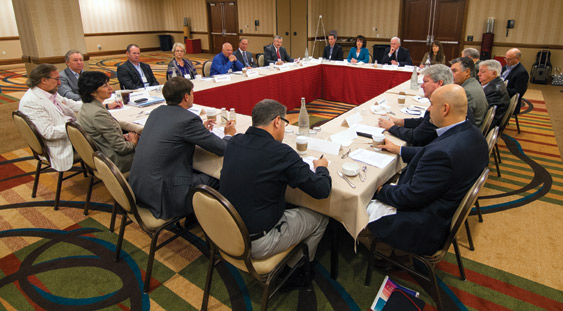Providers Grapple With Managed Care Inevitabilities
Meg LaPorte
1/1/2014
This is the first of a two-part series covering a recent Provider roundtable held in conjunction with the AHCA/NCAL convention in Phoenix, Ariz., in October. The purpose of the forum was to convene long term and post-acute care providers from a variety of states and markets around the country to shed light on how they are tackling the many issues that accompany the ever-growing cadre of managed care and Accountable Care Organizations around the country. The roundtable was sponsored by American HealthTech, at www.HealthTech.net.

Lengths of stay, hospital readmission rates, and five-star ratings remain buzzwords for long term and post-acute care providers as managed care works its way into markets around the country, according to a recent gathering of roundtable participants.
Be it a managed care organization (MCO) or an Accountable Care Organization (ACO), the consensus of the gathering was that it’s not a matter of whether it’s coming but a matter of when it’s coming. And the corollary to that is: Providers must know their quality measures, and they must know them very well.
In Kansas, where Medicaid managed care is just nine months old, all beneficiaries have been assigned to one of three MCOs, reports Fred Benjamin, chief operating officer of Medicalodges in Coffeyville, Kan. In fact, his company has embraced the roll-out of managed care in the state. “It’s been interesting so far,” he says. “I’m excited about it because we have an opportunity to rebuild the health care system the way we want to rebuild it. It’s not being dictated to us by the hospitals, and it’s not being dictated to us by somebody else. We have a fairly good relationship with a couple of MCOs. We have an opportunity to partner with them, and they seem very receptive to it.”
On the West Coast, California is currently enduring the “throes of managed care,” says Jim Gomez, chief executive officer of the California Association of Health Facilities. He notes that California now has 13 MCOs within the state’s eight largest counties, representing about 25 million people. “For about the last two-and-a-half years, I’ve been preaching to my members that it’s coming,” he says.
 “I meet with the head of the [health maintenance organization] association on a monthly basis to make sure those relationships are connecting and we’re saying the same thing. My biggest fear is the loss of independent providers in the state. The bigger companies, I believe, can integrate vertically and horizontally, and they are going to present a different picture to MCOs than an independent owner/operator who does only skilled nursing.”
“I meet with the head of the [health maintenance organization] association on a monthly basis to make sure those relationships are connecting and we’re saying the same thing. My biggest fear is the loss of independent providers in the state. The bigger companies, I believe, can integrate vertically and horizontally, and they are going to present a different picture to MCOs than an independent owner/operator who does only skilled nursing.”
In an effort to stave off this fear, Gomez has been educating independent operators in the state “so they’re in front of the curve,” he says. “I would say this at every workshop: All administrators should know their rehospitalization rates and their lengths of stay. And any administrator who doesn’t know these data should be fired.” Regarding length of stay, Gomez believes that it will drop from an average of 28 days to 21 days as a result of managed care. He points to Kaiser Health System, the largest player in the Sacramento area, as evidence: “Their average length of stay is 12 days,” he says. “They put their own nurse practitioners and docs in the nursing homes.”
In Massachusetts, ACOs are the main focus, as opposed to MCOs, says Naomi Prendergast, chief executive officer of D’Youville Life and Wellness Community in Lowell, who has been working with the state association to create a model ACO contract for other providers in the state.
“Forty percent of all fee-for-service Medicare beneficiaries are going through an ACO,” she says, adding that they are also creating educational programs for providers in order to get ACOs and skilled nursing facilities on the same page with regard to expectations on both sides.

“One ACO is in the process of going from 500 down to 50 [skilled nursing facilities] in its network,” says Prendergast.
“The sands around us are shifting constantly. We need to be aware of who now is affiliating with whom. It’s changing almost daily.”